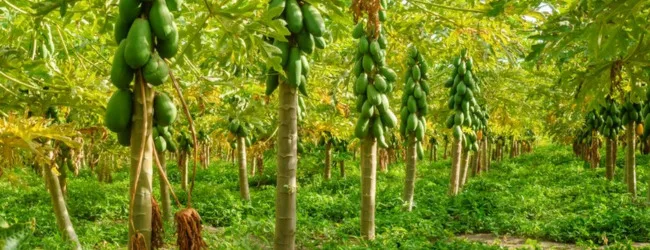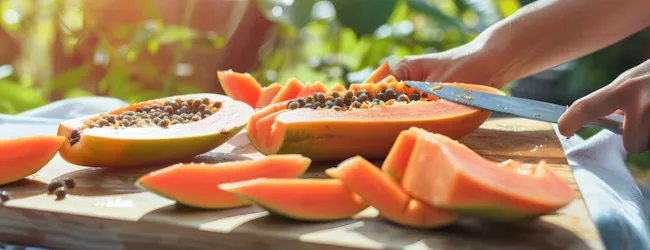Table of contents
- Why Choose Papaya Farming in India?
- Ideal Climate & Soil Conditions
- Best Papaya Varieties in India
- Step-by-Step Guide to Start Papaya Farming
- Cost of Papaya Farming per Acre
- Expected Yield & Profit Margin
- Government Subsidies & Loans
- Post-Harvest Management
- Market Opportunities & By-products
- Challenges in Papaya Farming
- Real-Life Example of a Successful Papaya Farmer
- Conclusion
- Frequently Asked Questions (FAQs)
Papaya farming is gaining momentum in India as a high-profit, fast-yielding fruit crop that requires low maintenance but gives excellent returns. This tropical fruit is not only in high demand domestically for its nutritional value, but also has export potential. If you’re looking to start a farming venture that is both economical and sustainable, papaya farming might be the perfect opportunity.
Why Choose Papaya Farming in India?

- Fast-Growing Crop: Starts bearing fruit within 6 to 8 months of planting.
- High Yield: One acre can produce 40 to 50 tonnes of papaya per year.
- Multiple Uses: Used in fruit juice, cosmetics, pharmaceuticals (papain enzyme), and processed food.
- Health Benefits: Rich in Vitamin C, fibre, and antioxidants.
- Growing Demand: Both domestic and international markets are expanding.
Major Papaya-Growing States:
- Maharashtra
- Tamil Nadu
- Andhra Pradesh
- Gujarat
- Karnataka
- West Bengal
Did You Know? India is the largest producer of papaya globally, contributing over 43% of world production.
Ideal Climate & Soil Conditions
- Temperature: 22°C to 35°C (frost-free climate).
- Rainfall: Moderate rainfall; irrigation is essential during dry seasons.
- Soil Type: Well-drained loamy soil with pH between 6.0 – 6.5.
- Avoid waterlogging areas to prevent root rot.
Best Papaya Varieties in India
| Variety Name | Characteristics | Region |
|---|---|---|
| Red Lady 786 | High yield, disease-resistant | Pan India |
| Pusa Dwarf | Compact plant, good for small landholders | North India |
| Coorg Honey Dew | Sweet taste, commercial use | South India |
| Arka Surya | High papain content | Karnataka |
💡 Pro Tip: If you want to start a Business but have too many doubts, connect with a Business expert from Boss Wallah for guidance – Check Out
Step-by-Step Guide to Start Papaya Farming
1. Land Preparation
- Deep ploughing to remove weeds and stones.
- Mix FYM (Farmyard Manure) at 20–25 tons/acre.
2. Seed Selection & Sowing
- Choose hybrid seeds with disease resistance.
- Nursery raising for 45 days → transplanting in the main field.
3. Planting
- Ideal spacing: 6 x 6 ft (approx. 1200 plants/acre).
4. Irrigation
- Drip irrigation is recommended.
- Watering is needed every 7–10 days.
5. Fertiliser Schedule
| Growth Stage | Fertilizer |
|---|---|
| After 30 days | NPK (10:26:26) |
| Flowering stage | Urea + DAP |
| Fruiting stage | Potash + Micronutrients |
6. Weed Control & Pruning
- Regular hoeing.
- Remove unwanted branches.
Cost of Papaya Farming per Acre
| Component | Estimated Cost (₹) |
|---|---|
| Land Preparation | 10,000 |
| Seeds & Nursery | 6,000 |
| Manure & Fertilizers | 15,000 |
| Irrigation | 8,000 |
| Labour | 12,000 |
| Plant Protection | 4,000 |
| Miscellaneous | 5,000 |
| Total | ₹60,000 |
ALSO READ | Makhana Farming: Techniques, Challenges, Market Potential & More
Expected Yield & Profit Margin
- Average Yield: 40–50 tonnes per acre.
- Market Price: ₹10–₹20 per kg (varies by season).
- Gross Income: ₹5–10 lakhs/acre.
- Net Profit: ₹3–6 lakhs per acre (1st year).
Government Subsidies & Loans
- NABARD Subsidy: 40–50% under horticulture schemes.
- PM Kisan Credit Card: For short-term credit at a low interest.
- Agri Clinics & Agri Business Centres Scheme: For entrepreneurs.
👉 Visit the NABARD Official Site for detailed eligibility.
Post-Harvest Management

- Harvesting Time: 7–9 months after transplanting.
- Storage: Store at 10°C–12°C for up to 2 weeks.
- Packaging: Use crates or cardboard boxes to reduce bruises.
Market Opportunities & By-products
✨ Selling Options:
- Local mandis.
- Supermarkets and organic stores.
- Online platforms like BigBasket, Amazon Fresh.
✨ By-products:
- Papain Enzyme: Used in the pharma and food industry.
- Dried Papaya: Export potential.
- Papaya Leaf Extract: Used in dengue treatment supplements.
Challenges in Papaya Farming
- Viral diseases (Papaya Ring Spot Virus).
- Pests like aphids and whiteflies.
- Waterlogging in the monsoon.
- Price fluctuation in local markets.
Tip: Use netting and drip irrigation to control pests and diseases.
ALSO READ | Ginger Farming: How to Grow, Setup Cost, Smart Tips & More
Real-Life Example of a Successful Papaya Farmer
Name: Suresh Patil
Location: Nashik, Maharashtra
Land: 2 acres
Profit: ₹12 lakh in one year using Red Lady 786 hybrid.
Strategy: Followed drip irrigation, organic fertilisers, and direct market selling to retailers.
Need Expert Guidance?
Starting a business can be challenging, but you don’t have to do it alone! At Boss Wallah, our 2,000+ business experts are ready to provide valuable insights and guidance. Whether you need help with marketing, finance, sourcing, or any other area of any business, our business experts are here to help you succeed
Confused about Which Business to Start?
Want to start your own business but unsure which one to choose? Explore Boss Wallah, where you’ll find 500+ courses by successful business owners, featuring practical, step-by-step guides on starting and growing various businesses.
Find your perfect business idea today
Conclusion
Papaya farming is a high-yield, low-investment opportunity for Indian farmers looking to boost their income quickly. With increasing awareness of healthy eating and export potential, the demand for papayas is only rising. By adopting the right practices and choosing the right varieties, even small landholders can earn lakhs annually from papaya cultivation.
Frequently Asked Questions (FAQs)
- Is papaya farming profitable in India?
Yes, farmers can earn ₹3–6 lakhs per acre annually. - What is the best season to plant papaya?
June–July or February–March. - Which papaya variety is best for farming?
Red Lady 786 is the most popular and high-yielding. - How many papaya plants are in one acre?
Around 1200 plants. - How long does it take for a papaya to bear fruit?
6 to 8 months. - Can papaya be grown organically?
Yes, using compost, neem oil, and organic sprays. - What are the common diseases in papaya?
Ring Spot Virus, Anthracnose, and Root Rot. - How much water does a papaya require?
Weekly irrigation (or drip system every 2–3 days). - Is papaya farming good for small farmers?
Absolutely! It’s low-risk and quick-return. - Can I export papayas from India?
Yes, especially to the Middle East and Southeast Asia.


